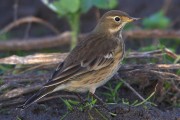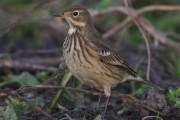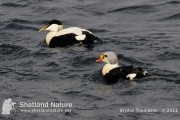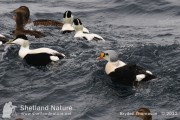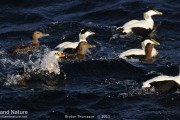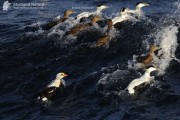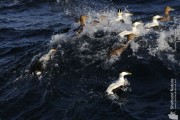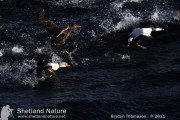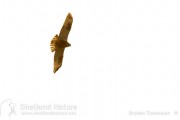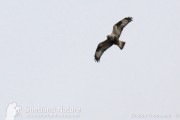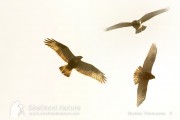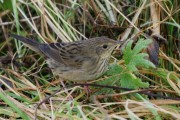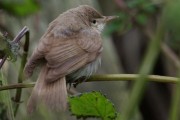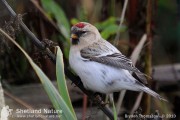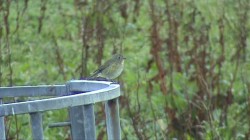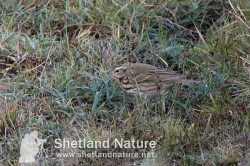Archive for the ‘Birding in Shetland’ Category:
Finding – a Team Effort
Posted by Martin Garner on Saturday 8th October 2011 | Birding in Shetland
Buff-bellied pipit, Quendale, Shetland, 08/10/11
I had finished two great weeks of guided birding SN groups and was set to enjoy a full (and more restful) day out with Roger Riddington. Roger and I had already enjoyed an excellent morning headlined by Citrine Wagtail, Isabelline Shrike and Pallid Harrier. The plan for us was to meet Paul Harvey and Brian Small around lunch time for a relaxed amble up the Quendale Burn.
Starting at Quendale Mill, some socialising with Andy Mackay and Mark Reeder meant I was lagging behind the other three and as I caught them up, laughter ensued as they pointed out I had no binoculars with me. Some birder! I ran back to the car, collected binoculars and caught up first with PVH. I had previously favoured the look of the Turnip/Kale field and suggested I would do it while the others continued working the iris-filled Burn. I asked his advice on how he thought the field could best be worked, and headed off. Nearing the top edge of the field, I noticed plenty of bird activity ahead: Twite, a Brambling, Redwings….I decided the fence line was the key zone and committed myself to work it carefully. Only taking a few more steps I noticed a movement amongst the cattle-chewed vegetables, put my binoculars onto it to see a bird that looked just like a Buff-bellied Pipit! It’s hard to say why it seemed rather obvious, the bird was in full view and not far away. I think partly I was fully genned up having made daily checks of numerous Meadow and regular Rock pipits for this very species. I had even made an excursion out onto the wild west side of Unst with Brydon T and our Shetland Nature group little more than a week earlier, specifically looking for Buff-bellied Pipit. Thus I had a high level of current familiarity with the common species.
Having made the initial shock assessment, I looked again and ticked off ‘big open face’, ‘rich apricot buff underparts’, ‘broad diffuse buffy wingbars’ and crucially the clinching feature for me; incredibly plain upperparts. I turned and none of the other three, now a field away, were looking in my direction. I didn’t dare shout, so I looked back at the bird, it was still there and it still looked just like a Buff-bellied Pipit. I turned around, praying now that someone would be looking my way, and thankfully Paul was. I waved frantically and all three were soon up and straight onto the bird. It took a moment for their shock to subside but all quickly concurring around a common thought- it really was one!
During the next 15 minutes it took a couple of shorts flights when we twice heard it give the rather distinctive call (again against the backdrop of multiple daily encounters with Meadow and Rock pipit) sort of Meadow Pipit x Grey wagtail. We watched and rehearsed the key features though bins and my shared ‘scope, occasionally losing it in the difficult vegetation, as Roger went to get more ‘scopes. Shortly after, news was put out, and within 25 mins of the first sighting, the initial vanguard of some 50-70 birders appeared. By now we had lost it in a denser weedy patch. Ten minutes later Brian picked it up, but it quickly took flight, landing over a third of a mile away in a grassy field on the edge of the Burn. Roger and Brian agreed to organise a flush line and eventually the bird was pinned down in the quarry area and all present got reasonable looks. Somewhat regrettably the pressure to release news and subsequent stampede meant I had little further chance to study, record plumage in greater detail and record the call. Modern birding! I gather it was last seen on 13th October and a number of excellent photos were taken. I suspect the Quendale regulars have much better set of notes on the bird!
Martin Garner
Permalink
King Eider update
Posted by Brydon Thomason on Wednesday 6th April 2011 | Birding in Shetland
Only a matter of weeks after discovering the 1st winter drake on Bluemull Sound, this resplendent drake arrives off Uyeasound, Unst. As pleased as I was with the young King back in February, this magnificent looking chap really did raise the pulse. You can tell of course from my last King Eider posting I do indeed have something of an Eider afliction/addiction but with very, very good reason. They are all stunning seaducks and always a joy to watch, photograph or indeed in this case scan through large flocks in search of the rarer forms.
Any how, they are way too handsome for my words to do anywhere near justice, here are some images of the King from over the past few days.
Permalink
The King of Eiders
Posted by Brydon Thomason on Sunday 27th February 2011 | Birding in Shetland

A memorable day indeed and a very welcome find back in March 2006. A pristine drake in his full and exquisite breeding attire.
There can be few species of bird (let alone sea duck) as exquisite in appearance as a drake King Eider. It is hard to find a word that describes just how strikingly ornate the head and bill pattern is on a fully mature adult but I guess with the title of King enough is said. It is indeed rather apt that their Latin name, spectabillis means remarkable!
King Eiders have a largely circumpolar breeding range and are quite common throughout various regions of the high Arctic. In Britain they are regarded as a ‘national rarity’ with their having been somewhere in the region of 200 plus records of the species in the whole country. It was first added to the British list in 1832. Perhaps not surprisingly and like so many other species of Arctic vagrant to reach Britain, Shetland alone has hosted at least half of these.
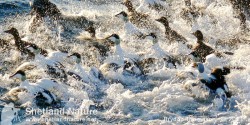
Eiders in action, the tightly bunched flock race across the water’s surface as a small boat cruises past.
Historically Kings have regularly occurred throughout the isles and typically found associating with the local Eider flocks as singles and even occasionally multiples. Their beautiful pale, frosty- blue crowns, clown like eye make-up and bulbous orangey-yellow bill shield atop of the red bill are usually easily picked out amidst even a large flock of our local Dunters (the Shetland name for Eider). Structurally they are usually obviously smaller and a little more compact too by comparison.
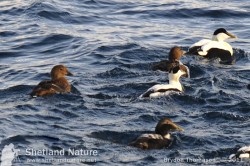
Female King Eider. A much more subtle bird indeed, this ‘Queen’ spent just a couple days amongst the Bluemull Sound winter flock in November 2008.
Immature drakes and females are however quite a different matter. To the untrained eye any of these plumages will very often blend in amongst a Dunter flock without a second glance. Females are what could be compared and referred to as ‘little brown jobs’, although that is really a descriptive term for small featureless brown warblers, pipits, buntings and so on.
They are of course every bit as adorable to me, so cute and compact in appearance with such subtle features. With experience though these subtleties can become quite striking and are the very reason they stand out, if that makes sense! A small brown, seemingly featureless duck may seem challenging to pick out amongst the very similarly plumaged local females.
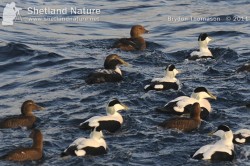
‘Queen’ Eiders have been known to spend as long as six days on the nest without leaving and will scarcely feed during the 22-24 day incubation period.
A combination of these features do however create a surprisingly distinct appearance; smaller and more compact overall size and structure, shorter and neater black bill which runs up onto a much less angular head profile, a ‘teddy bear’ like eye which shows a slight ‘tear drop’ line falling away behind and also a ‘grinning’ line which runs back a little from the closed gape. These latter two features especially combine to show a very cute but actually rather sad facial expression. The feathering also runs further down from the forehead onto the bill than on our Eiders.
In addition to these features are two others which can sometimes be just that little bit harder to see; the black flank barring forms arrow head like chevrons as opposed to the straighter and more vertical bars on a female Eiders flanks, they also have feather formations that appear on their back which are often raised creating tiny ‘sails’ which occasionally stand up like little dorsal fins but these are never as prominent as on a drake.
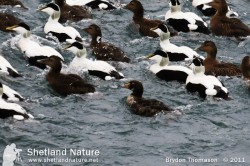
Interestingly for a sea duck, King Eiders are known to migrate overland in some populations and have been known to reach altitudes of up to 1,000m. I wonder where this young fellow was hatched?
Immature and sub-adult plumages of King Eider can be just as subtle, especially on a first winter bird. This is exactly the plumage I found one in in mid-February amongst the Eiders on Bluemull Sound, my favourite and premier winter birding site. The ‘young Elvis’ (“ah- hu hu”) was amongst a flock of around 150-200 Dunters, (less than quarter of the wintering flock there) and is actually the second of this age to be seen in Shetland this winter. Similar to the structural differences described in females, to me he was quite easy to pick out but it was his orangey yellow bill tones and compact shape that made him immediately identifiable.
Some have described this plumage of King as grotty or drab but although I can see why, I couldn’t disagree more, finding the little fellow made my day! This young King was actually the ninth King Eider I have ever found in Shetland, having previously found two females, two first winter drakes and four adult drakes (all were single birds amongst Eider flocks). And indeed a couple of these were known to be annual returnees for a couple of winters. I have also been fortunate to enjoy many others over the years in Shetland.
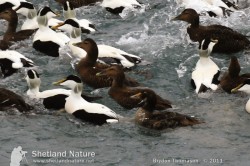
The first winter plumaged King huddles together amongst the melee of Dunters, the adult drake behind the two centre females is presumed to be of the ‘Northern’ form borealis. A novelty shot to have them both in the frame (note his tiny pert white ‘sails’ on his back and brightly coloured bill).
Searching for this and indeed other rare forms of Eider is undoubtedly one of my main winter birding motivations. One of these forms, regarded as subspecies or race, is Borealis or ‘Northern Eider’ (as they are also known) which are thought to hail from Nearctic regions. Several of these have also brought me much joy in their discoveries amongst their local cousins but as is the case with so many subspecies their identity, taxonomy and origin are still under discussion. And finally there is the one that all birders dream of finding (yes that’s right and quite often too), Steller’s Eider! Oh how I hope I can write a finders account for one of those, someday…
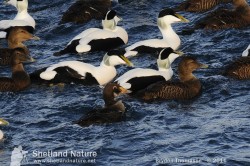
1st winter King Eider, Bluemull Sound, 3rd March 2011.
*Update* What a difference a bit of light makes! A more recent image taken on 3rd March…
Permalink
Rough-legged Buzzard(s) – a double whammy!
Posted by Brydon Thomason on Wednesday 5th January 2011 | Birding in Shetland
With 2010’s influx of Rough-legged’s in Britain in late autumn/winter my enthusiasm to find one for myself (having never found one) was peaking and given there had already been a few, I was fairly sure I could be in with a chance. I had made several trips up the very rough track to Valla Field (a distinct advantage of driving a Freelander!) and Saxavord and other similar sites on Unst since late October as I figured they were fairly likely RLB sites although Snowy Owl and Gyr are also on my radar for these sites.
Persistence at last paid off when on the 29th of December my luck was in and soaring along the very wild and rugged West facing rocky hill side of Valla Field was a stunning Rough-legged Buzzard. How perfectly placed it looked in such a beautifully remote and dramatic landscape. Two days later I took my wife Vaila and one year old son Casey along and enjoyed good but distant views, all except wee Casey of course who slept through the whole encounter!
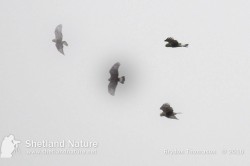
Rough-legged Buzzard, montage, December 29th 2010.
The sheer rocky ridge along the west facing hill (not at all dissimilar to the Arctic landscapes they are so at home in) which drops down to a flat and fairly green plateau called Collister which is scattered with small lochens and old ruined crofts which overlook the oceanic Atlantic horizon to the West. It is undoubtedly one of my favourite places in Shetland with its stark beauty well out of view of any main roads.
It was here that I was drawn to for my New Year’s Day walk (which is something of a personal tradition). Having walked the hills which lead to the North I had been slightly disappointed not to have seen the Rough-legged and continued down to Collister. To my surprise I met the Buzzard drifting north as I continued south along the cliff-tops.
I hurried across to the foot of the hills where I watched it gain height and begin to soar and glide in the up-drafts. But hold on a second I thought to myself as watched on in disbelief through my trusty Zeiss 10×42’s, a second bird drifted into my field of view, there was two of them!! I couldn’t and for a second didn’t believe my own eyes, two Rough-legged Buzzards together. I had ended the year by finding one only days before in 2010 and I began the year of 2011 by finding another, an RLB double whammy- happy New Year indeed!
Permalink
The Shetland Nature Autumn Adventure – 2010 Report
Posted by Martin Garner on Sunday 19th December 2010 | Birding in Shetland
This was my first birding tour, and it’s hard to see how it could be bettered – good weather brought good birds to be enjoyed in beautiful surroundings, expert leading and each hard day’s birding was finished off with a terrific meal and lots of laughs.Paul-Bright Thomas
With the terrific team effort involved in Britain’s 3rd Taiga Flycatcher (read full finder’s story) as well as self found Marsh Warbler, Yellow-browed Warbler and Barred Warbler our promotion weekend in autumn 2009 had set a rather high standard! Would we be able to maintain it the following year?
You decide. Here’s a flavour of our outstanding 2010 autumn birding adventure – from team effort finds such as Blyth’s Read Warbler, White-billed Diver and Lanceolated Warbler to quality mega’s such as Sykes’s Warbler (s!) and Buff-bellied Pipit…
» Read the full eight-day round up …
Permalink
Water Pipit, a first for Shetland
Posted by Brydon Thomason on Wednesday 24th November 2010 | Birding in Shetland
Unst managed to turn up its second first for Shetland in 2010 with a Water Pipit at Norwick on 21st-23rd November. Here is a finder’s account from Brydon Thomason.

Water Pipit at Norwick. Photo by Larry Dalziel.
November is traditionally a month never to be underestimated when considering winding down an autumn birding in the isles. It is a month that seldom passes without at least one surprise rarity. Personally speaking, November has indeed been more than kind and has brought a diversity of rarity finds such as Gyrfalcon, Lesser Scaup and Hume’s, Arctic and Dusky Warblers, to name but a few – along with multiple King Eider and White-billed Divers.
With that said though, it can certainly be a hard month to keep motivation going when out in the field. Migrants can be very few and far between and suitable habitat and cover for a potential rarity is often all but weathered away.
Although birding time had been at something of a premium, I had still had my usual November aspirations of finding Pine Bunting or Desert Wheatear but, alas, once again it was to be a year of neither! But what I was to find, in a local context at least, was to be a much rarer bird than either of these …
It was our son Casey’s belated first birthday party so, with the Sunday dinner preparations all in hand, and along with my parents, wife Vaila and our birthday boy we set out for a nice pre- dinner outing. Having enjoyed a lovely walk at Skaw beach we made time for a drive along the shore-side road which overlooks one of Shetland’s iconic vistas, Norwick beach.
As we drove towards the turning point, a passerine flitted over the verge and down toward the beach. I caught no more than a fleeting glimpse, but what I did see certainly intrigued me; the amount of white in the outer tail suggested pipit, but perhaps even a bunting or lark were all possibilities given how poorly I’d seen it. In any case any pipit, lark or bunting in late November is worth checking; they are few and far between by late November.
Leaving the car running and family in it, I peered over the bank and down onto the dead seaweed smothered beach only to see a female Black Redstart fly away from me – confused, my eyes quickly then fixed on my mystery bird flying off along the beach. It was certainly a pipit, but which? It showed quite a lot of white in the outer tail and seemed to show some brownish tones. I knew something was unfamiliar about it as I watched it fly to the far end of the beach. I quickly shouted to Vaila to come back for me ‘in a bit’, having no earthly idea how long that would be!
I relocated the bird at the far end and got my first ‘on the deck views’. It was some 40-50yards away and I had no scope! The split second thoughts of Blyth’s (more by its apparent choice of habitat than anything else, feeding along the edge of dunes) were expelled instantly, not least on plumage tones and underpart streaking but also structure.
Its underparts were strikingly clean white, plus the white in the tail ruled out local Rock Pipit and I was fairly certain littoralis was not in the picture either. Water or Buff-bellied Pipit were all that were possible, I thought to myself. Without even getting the chance to stalk forward and get better views, a dog walker flushed it, causing it to fly over my head and all the way back to the far end of the beach, calling once as it went – a rather flat Rock Pipit like ‘psp’- surely it must be a Water Pipit?
It had been several years since I had heard Buff-bellied Pipit in the States but I was pretty confident this was not one. I began to really train my thoughts on Water Pipit, a species I had never even seen in Britain, and not since a UAE trip many years ago, and even there I had admittedly paid them little attention. BBP was very much fresh on my radar having seen the bird at Eshaness only a few weeks previously, but this was just never coming across with a Buff-bellied Pipit vibe to me.
When I returned to the other end, my father was at the wheel of my Freelander and informed me the others were back home (only a few minutes up the road). I grabbed my scope but had no tripod with me. A blustery and very anxious few seconds through the scope for the first time appeared to confirm to me the following basics:
- Tail, coverts and tertials did not appear strikingly blackish or crisply fringed as in BBP
- The mantle appeared to be visibly streaked as opposed to rather plain BBP
- Streaking on clean white underparts was quite bold all the way down flanks
- Slightly browner tones around rump area
- Perhaps most importantly the lores appeared to be quite distinctly marked and not open
- Nor did it show the striking eye crescents of BBP – It had to be a Water Pipit I thought to myself.
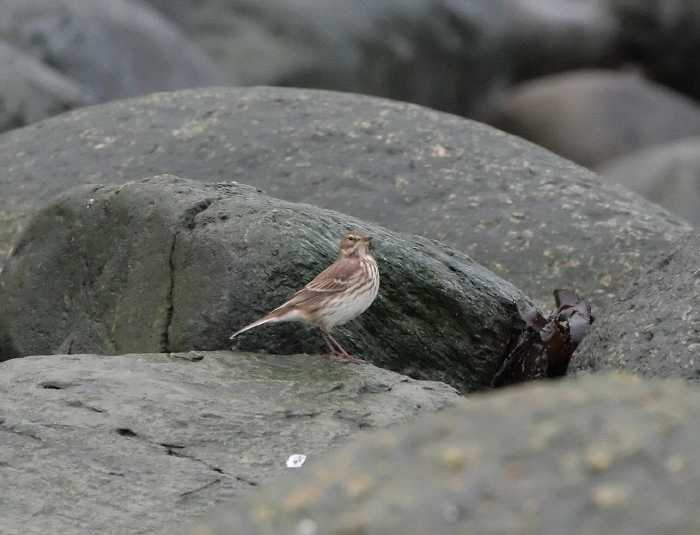
Water Pipit at Norwick. Photo by Rob Brookes.
All this had happened in under ten minutes, it was just after 1500 and light was failing fast, I had to get news out to the ‘Unst boys’. Unusually, I had no camera with me nor did I even have a field guide to hand. We drove off up the road to get phone reception and where Mr P (Mike Pennington) was my first and very definitely priority call. Thankfully he answered and within ten minutes was by my side followed swiftly by Robbie Brookes – I knew young Rory T was off island.
Water Pipit was certainly a first for Unst and I was also aware that it would almost certainly be a new species for all the Shetland ‘listers’ but didn’t actually realise at the time it was in fact a county first! Whilst anxiously trying to relocate the bird with Mr P I relayed all that I had noted. Thankfully without too much distress (although perhaps maybe with a little ‘tension’ in the air!) we pinned it down back feeding on the dead kelp on the tide line of the beach, which proved to be its favourite spot. We enjoyed fairly good and definitively conclusive views through a shared scope but with light that was by now bordering on appalling neither Mike nor Rob got anything better than poor record shots.
By about 1530 we had lost the bird due to poor light. On route home we put the news out and I was back home in time for getting the ‘tatties’ on and set the table – a county first and my son’s first birthday party, the perfect Sunday!
Permalink
Red-flanked Bluetail
Posted by Rory Tallack on Friday 15th October 2010 | Birding in Shetland
As a relative newcomer to birding, this autumn has challenged my ability more than any other. The Skyes’s Warbler in August was closely followed by some particularly problematic identifications in the forms of Blyth’s Reed and Paddyfield Warblers.
A few weeks later and I was beginning to feel as though I was not far from being ‘all birded out!’ However with Will Miles back in Shetland after three weeks on Fair Isle and October only half way through, I knew my autumn wasn’t over just yet…
After a quick ‘Izzy Shrike’ twitch we arrived at Troswick where Will’s girlfriend was staying temporarily. It was getting close to dark so birding was far from my mind and with Sarah only 20m away, it was even further from Will’s. As I turned off the engine I thought I saw something move out of the corner of my eye. “Was that a warbler?” I asked. “Not sure, but it’s just landed on the fence there”. About 5m from the car a bird was sat on a wire fence. In this light, even at such close range, ‘bird’ was about as much as we could work out. We both lifted our bins. It was facing us, clearly showing off pale underparts, orangey flanks and a pale eye-ring. “Good gosh, Will, I do believe it’s a Bluetail”, I exclaimed (or words to that effect). The look of disbelief on Will’s face suggested he had come to the same conclusion but he was unable to get anything resembling a word out. Twenty minutes later it was dark and despite shaking hands and next to no light I managed to get some identifiable footage of the bird (video grab above). Fifteen minutes later it was dark and the bird was never seen again.
I used to believe that the most satisfying finds are those which require thought or those which have been hard-earned after hours in the field. This one, however, has made me think again – no effort, easily identified and perhaps my favourite find to date.
Although ‘Bluetail’ has in recent years become much more regular in Britain, any birder will surely agree that it still retains an element of that near mythical status it once had as a vagrant. This bird was one of up to a record breaking nine individuals in Shetland this autumn.
Rory Tallack
Permalink
Olive-backed pipit
Posted by Brydon Thomason on Thursday 14th October 2010 | Birding in Shetland
14/10/10, SHE plantation, Baltasound.
I have such very fond memories of Olive-backed pipit and it remains one of my favourite rarities. One of the main reasons for my soft spot for the species is undoubtedly because it was one of my first ever BB self finds that wasn’t either a Little Bunting, Short-toed Lark or Arctic Redpoll. And personally speaking it is a real classic autumn ‘Sibe’.
On more than one occasion I have found two in a single day and once even two together, in the same crop field as a Richards Pipit way back in October 1992. With that said though since 2003 there has been something of an OBP injunction clouded over me with several years having passed without finding one.
An hour long circuit of some of Baltasound whilst our son was down for an afternoon nap seemed like a splendid idea and having spent the morning working I had convinced myself it was earned. The neighbouring gardens of my mother-in-laws produced little more than a couple of ‘Sibe Chiff’s’ so I continued on to Setter’s Hill Estate plantation where another ‘Sibe- chaff’ showed well. My hour was not yet over so I continued on to circumnavigate the estate and check the lush gardens round the back.
Almost feeling a sense of disappointment of not having seen at least a Yellow-browed warbler I continued on back toward the main road (though two of the chiffs did appeared to be new in), where well away from the gardens I had pinned hopes on rose a fairly fresh looking pipit from the ditch. It landed for a split second but took off before I’d even raised my bins to my eyes- “Prssz-Prssz”, its rather explosive and rasping double call was instantly familiar to me, surely this had to be an OBP!
Typically it flew quite a distance, all the way back over the housing estate to the pines. I cursed my technophobic tendencies for not having my ‘Remembird’ in action as I hurried back to the plantation. I did not want to let this slip and knew well that with- out views on the deck it was lost!
Thankfully following a rather cautious approach to the pines I found it feeding in the lush grass where the following distinguishing features confirmed it’s ID;
Black on its beautiful and rather dark unstreaked olive- toned mantle
Typically striking ‘mascara marked’ facial pattern, with buffy yellow smudged lores and bold white ‘super’ and post ocular spot
Bold ink black breast and flank streaks which almost merged together on sides of breast
Get in- a classic OBP was in the bag!
I returned later that day to try to get some photo’s but in very poor evening light only managed a couple of grainy record shots. Next day though Robbie Brookes managed better ones.
Permalink


